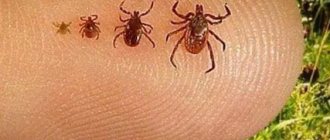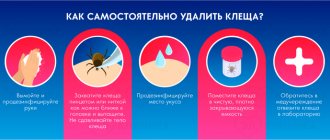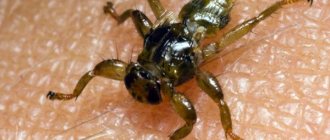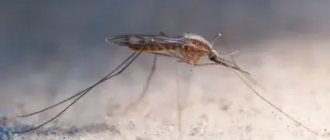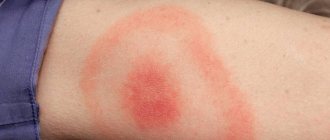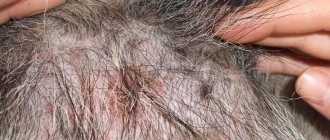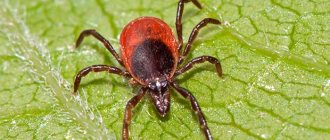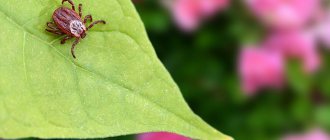The onset of warm days makes it possible to go out into nature, which can often be overshadowed by the discovery of a tick bite on the body. In the hotter seasons, this problem is especially relevant and every year parasites are found even in those regions where they had not previously been noticed.
The bite itself does not pose a danger to humans; the threat lies in the fact that the parasite can be a carrier of the causative agent of serious diseases, the consequences of which are not always correctable.
In order to protect yourself, it is important to know what a tick looks like under the skin and what the difference is between a sucking parasite.
A bit of Wikipedia
Ticks are animals belonging to the class of arachnids. To date, more than 53 thousand species have been identified and described , including microscopic mites that cannot be detected with the naked eye. This type of insect is found in all corners of the planet, even in Antarctica.
Interesting fact! In Antarctica, ticks parasitize penguins and local bird species. Another proof that abnormally low temperatures are not terrible for this type of arachnid.
Encephalitis tick
Not all types of ticks are dangerous to humans, only some of them. The most dangerous is considered to be a whole order of arachnids called Ixodida . They are responsible for the spread of encephalitis, tick-borne borreliosis (Lyme disease) and other infectious diseases. They are the ones you should be wary of and avoid meeting with them in every possible way.
Features of the structure of the insect
A tick is an insect that looks very similar to a spider. It has an oval-oblong body and a small head. The photo shows what an ixodid tick looks like. The parasite has eight limbs that function as paws, like arthropods. But in front, on the head, there are four more claw-like paws, which the parasite needs to gnaw through human skin and grab onto a blood vessel. These parts of the head, the chelicerae, form the piercing-cutting mouthparts of the insect. The legs have suction cup bristles that help the tick to firmly attach itself under human skin.
Mite
The length of the insect's body usually reaches 3 mm. The body itself seems to be divided into two parts - the head and abdomen, and the head is quite small. During the feeding process, the belly can increase many times in size, filling with blood sucked from the victim. What does a tick's head look like in the photo:
- Powerful mouthparts with a proboscis.
- A gnawing pair of appendages – chelicerae.
- Grasping devices – pedipalps.
- Four simple eyes.
All joints together form the head of the tick.
The body of a blood-sucking insect is covered with a chitinous shell; it looks like a protective covering, which is why insects are sometimes called hard mites.
Types of ixodid ticks dangerous to humans
Correctly identifying the type of tick is an important and useful skill, especially for those who live in potentially dangerous regions of Russia. Identification of the species allows us to understand what infections the tick can carry, which will simplify the work of doctors and increase the chances of stopping the disease at the initial stage of development.
Black-legged tick
Black-legged tick (Ixodes scapularis)
First on the list of dangerous species is the black-legged tick (also known as Ixodes scapularis). It lives mainly in Europe and on the southeastern coast of North America. Sometimes it is found in the European part of the Russian Federation, but rarely.
Can carry many dangerous infectious diseases, including Lyme Disease. There are also cases of infection with granulocytic anaplasmosis, and less commonly with babesiosis. An example of what a tick looks like (photo).
The bite of the black-legged tick is invisible. The victim does not feel the moment of the bite itself, nor the feeding process . Usually, it actively drinks blood for 3-5 days, and then falls off on its own, noticeably increasing in size (up to 10-12 mm).
Dog tick
Dog tick (Ixodes ricinus)
Dog tick , also known as Ixodes ricinus, is a subspecies of the Ixodes family that is a carrier of severe infectious diseases. The most common are individuals infected with tick-borne encephalitis and borreliosis; less commonly, dog ticks carry infections such as Marseilles fever and tularemia.
Distributed in the European region and Asian countries. In smaller quantities in Africa and North America (USA). The color and size of the individual is not much different from other representatives of the order Ixodidae, except for a small dark spot (or several) on the back.
Important! There is a myth that dog ticks only bite dogs. This is a misconception that arose primarily due to the name of the species. Dog ticks bite both animals and humans.
Taiga tick
The most common and dangerous species of ixodid in Russia is the taiga tick (lat. Ixodes persulcatus), also known as the encephalitis tick. It is he who most often becomes the culprit of mass infections with encephalitis , which are recorded annually in various regions of the Russian Federation. It can also carry other dangerous infections characteristic of this species.
Female and male taiga tick (Ixodes persulcatus) waiting for their next victim
The female has a standard red body color and black limbs. The male is monochromatic, dark, closer to brown. They usually sit on the grass waiting for prey. Distributed throughout Russia. Particularly active in regions separated from the capital and the Far East, in particular.
Interesting! Many are sure that ticks can jump and climb trees and then fall (bend down) on the victim. But this is just a myth. They usually do not rise higher than one meter above the ground and prefer to sit in tall grass and various bushes. More details on Yandex.Q.
Meadow tick
Meadow mite (Dermacentor reticulatus)
One of the dangerous subspecies of ixodids is Dermacentor . There are two types of danger: meadow and pasture ticks. The meadow tick (Dermacentor reticulatus) is a typical inhabitant of open meadows and pastures, forest edges and clearings. Widely distributed in Siberia, Europe and the European part of the Russian Federation. After a tick bite, already familiar diseases can occur: encephalitis, Lyme disease and many others. What does a tick look like (photo).
This species is popularly called brown ticks because of its characteristic color. Individuals of this species are slightly larger than their counterparts, so they are better visible in the grass. Appears several weeks earlier than the taiga tick , since it is more resistant to low temperatures.
Pasture mite
Grass mite (Dermacentor marginatus)
A “close relative” of the meadow tick is the pasture tick (Dermacentor marginatus) . Externally, these two species are very similar. Only scientists involved in the search for new species and classification of arachnids will be able to find differences in appearance.
In addition to habitat preferences (meadows, pastures, forest clearings), it carries the most dangerous diseases, including:
- tick-borne encephalitis;
- Omsk hemorrhagic fever;
- rickettsiosis;
- dermacentorosis;
- Crimean-Congo hemorrhagic fever;
- can also transmit pathogens of brucellosis;
- tuleramii;
- Key fever;
- and even plague.
It is noteworthy that the tick first makes a couple of test bites, and only then sticks to the victim for several days.
Ticks of the Argasidae family
Agras mite (Argasidae)
Another type of tick from the order Ixodida is agras ticks (Argasidae) . They have significant external differences from ixodids. In particular, their shell is soft and the color is dull brown.
The danger to humans is mainly infectious diseases: tick-borne relapsing fever and borreliosis. They live mainly in caves, burrows, and various crevices . They hunt at night, but can bite a person during the day in the shade.
Important clarification! If you are bitten by a tick, this does not mean that you will definitely get one of the infectious diseases. You just need to remember that every tick bite is a big risk. In approximately 90% of cases, people are bitten by “clean” ticks, that is, uninfected ones.
Misconceptions and ignorance
I learned about ticks (forest ticks) at the age of 13 and began to be afraid, because they only scared me and no one had any useful information.
There are legends about them even today among the people. At least one of my friends found a tick on themselves every year. My father brought them to the dacha on birch brooms almost every summer and periodically on himself. I have never been their victim, I did not take any precautions, I carried flower bouquets from the forest, I had no idea what ticks looked like, and I only saw them 20 years later on the Internet. What I knew before: they live on birch trees, run fast, supposedly know how to jump and even fly. They jump from above (obviously, you can only jump from a birch tree). If the tick has already bitten you, you need to lubricate the bite with sunflower oil so that the tick begins to suffocate and crawl out on its own, and there you are, waiting with cotton wool. They are attracted to light-colored clothing. Encephalitis or paralysis is almost inevitable.
None of this is true. Some hospitals may still tell you to use oil. Almost any source of information is the word “no” without any explanation. And the biggest problem is the panic that happens when someone finds a tick on themselves, knowing only gossip about it.
Even if you think that you know everything, read this article.
What ticks are found in Russia, Ukraine and Belarus
In our latitudes there are most taiga ticks, less black-legged ticks. Individuals of the dermacentor species (meadow and pasture mites) are also often found. In the southern regions you can find a couple of agras species.
In Russia, ticks are distributed almost throughout the entire territory, but infected individuals are found in the central, eastern and northern regions . Especially many cases of encephalitis infection are recorded in the Tomsk, Sverdlovsk, Kurgan and Tyumen regions, as well as in the Altai Mountains and Buryatia.
Habitat area of encephalitis ticks
As for Ukraine, infected ticks are more common in the central regions, less often in the western and eastern regions. Approximately the same picture is observed in Belarus.
Natural enemies
There are a large number of means of combating parasites. Nature also made sure that their numbers did not grow indefinitely. Arachnids are an important link in the food chain for many insects, birds and other animals.
Natural enemies that feed on ticks in nature and thereby control the arachnid population include:
- frogs;
- other types of arachnids;
- birds (sparrows, thrushes, starlings and others);
- ground beetles;
- dragonflies;
- ants;
- wasps;
- riders.
Natural enemies for ticks in nature are also fungal spores, which have a detrimental effect on them and cause fungal diseases in them. Therefore, it is so important to prevent large-scale burning of grass and treatment of large areas with acaricides. This will lead to disruption of the natural balance and as a result, not only the parasites themselves will die, but also their enemies. In addition, most of the tick eggs will survive, which will lead to their rapid reproduction and spread.
How does a tick get to a person?
Most species of ticks have extremely poor vision, with which they can only distinguish shadows. No images, colors or other privileges available to a person. However, evolution has awarded these insects with a much more formidable weapon - hypersensitivity.
They respond well to the slightest changes in temperature, movement, various odors (including those of humans), changes in humidity, and are able to pick up vibrations. Usually, to find a victim, a tick climbs onto bushes or grass and freezes in anticipation, with its front legs spread wide.
Interesting fact! Sensors, located mainly on the legs of the tick, are able to detect the smell and movement of the animal (human) at a distance of 8-10 meters.
The most comfortable conditions for living and hunting are forests with tall grass, and less often fields . As soon as the victim approaches the tick, it will immediately grab onto the person’s clothing, skin or hair. As for the ability to cling, ticks have no equal.
Next, the tick looks for a place to bite, choosing mainly areas with thinner skin: on the neck, groin, behind the ear, etc.
Do these arachnids need water?
To maintain vital activity, in addition to blood, ticks need water. They prefer warm, humid places and avoid dry areas of the habitat. When waiting for a victim for a long time on the tip of a blade of grass or a branch of a bush, the parasite loses moisture and needs to replenish it. The main loss of water by the bloodsucker occurs by evaporation through the cuticle covering the body and through the tracheal system, as well as with waste products that are excreted from the body.
It is also useful to read: Where ticks usually live in nature: typical habitats
Only a small number of ixodid species drink water as we know it. Most ticks absorb water vapor from moisture-saturated air, for which they descend from their hunting post to the ground and crawl into cracks in the soil or fallen leaves.
To replenish moisture, ticks crawl under fallen leaves or into cracks in the soil.
Absorption of water vapor occurs in the preoral cavity of the arachnid, where hygroscopic saliva is secreted. It is she who absorbs water vapor from the air and is then swallowed by the tick.
First signs of a tick bite
As already mentioned, a person does not feel the moment of a tick bite, nor how it drinks blood for several days, gradually swelling. The reason is a special substance that has anesthetic properties, which the tick injects at the time of the bite.
Unfortunately, after a bite there are practically no signs on the human body. Only after 2-3 days does redness and a red circle characteristic of a tick bite appear at the site of the bite. On the last day of the “meal” the bite site changes color to light yellow.
Therefore, it is extremely important to inspect the body for ticks after going to the forest or park. If you live in a potentially dangerous region, it is worth following basic safety precautions, since the best treatment for a tick bite is the absence of a bite itself.
Eggs
In the spring or late summer, having had enough of the blood of its victims, the fertile female tick makes a clutch consisting of 2.5-3 yew. eggs What do tick eggs look like? They are a very large cell, which consists of a nucleus and
cytoplasm, also covered with a two-layer membrane of different colors. Tick eggs come in a variety of shapes, from oval to square, flattened and elongated.
How to remove a tick (Video)
Before moving on to methods for removing ticks, here is a small list of what should never be done:
- Do not pick up a tick with your bare hands . Always use medical gloves; if not possible, use a bag.
- If someone advised you to douse a tick with gasoline, vodka, or cover it with Vaseline, do not listen! There is a myth that if you block the supply of oxygen, the tick will come out on its own; this is a dangerous misconception. The tick won't come out. But injecting saliva, rich in encephalitis pathogens, into the blood is easy.
- Do not press on the tick or pull it out using the usual method. The problem is that with such actions, the tick will most likely inject saliva into the blood, which may be infected.
The best advice we can give if you are bitten by a tick is to go to the nearest hospital immediately . There, the tick will be properly removed, the wound will be treated, and the insect will be sent for analysis to identify possible infections. If any disease is detected, it is much easier to treat it in the initial stages.
But if it is not possible to go to the hospital, then you should use one of the methods for properly removing a tick.
The first method is using special tweezers, which you can buy in advance.
The second method (field) of removing a tick is using a thread.
Removing a tick with a thread (photo)
Important! After fixing the tick with tweezers or thread, you need to unscrew it! Do not pull, do not press. Please exercise caution and patience.
Interesting Facts
- The smallest tick in the world, measuring only 0.08 mm in length, is even listed in the Guinness Book of Records.
- Three adult ticks, if placed together, will look like the dot at the end of a sentence in size.
- At birth, not a single tick is a carrier of dangerous infections; they only acquire them after parasitism.
- A female ixodid tick can eat 100 times more food than a male. After such a hearty meal, the female can increase in size by 150 times.
How dangerous are ticks for humans?
As mentioned above, a tick bite can trigger the development of various infectious diseases. Some diseases are more dangerous and can even lead to death or disability. Others are not as dangerous, but still require medical treatment using appropriate medications.
Tick-borne encephalitis
The worst thing that can happen to a person who is bitten by a tick is infection with tick-borne encephalitis . This is a dangerous disease that, if not treated appropriately and promptly, can lead to death. Sometimes the spread of infection is limited by the development of pathologies leading to disability.
Tick-borne encephalitis infection affects the gray matter of the human brain. Often the spinal cord membrane is additionally damaged, which can lead to partial or complete paralysis. These disorders can lead to difficult-to-reverse psychiatric and neurological complications. If treatment is not started, the disease leads to death.
The most dangerous type is considered to be tick-borne encephalitis, which is common in Siberia and the Far East . Mortality statistics from this type of infection are higher than from the European type of tick-borne encephalitis.
The first symptoms of the disease may appear after 10-14 days. As a rule, after such a period, doctors have to deal with the consequences, since within two weeks the disease completely takes over the human body.
For emergency prevention of tick-borne encephalitis in the first 24-72 hours after a bite, immunoglobulin is used . If you do not take an immunoglobulin tablet in the first three days, encephalitis begins to develop along with complications. Antiviral medications are often used after 72 hours after a tick bite, but their effectiveness has not been clinically proven.
Lyme disease (tick-borne borreliosis)
Tick-borne borreliosis is the most common disease that is transmitted to humans after the bite of an infected tick. The causative agents are spiral bacteria of the genus Borrelia. The number of cases of infection is 3-4 times higher than in the case of encephalitis. The danger of borreliosis lies in the secretive and asymptomatic course of the disease.
In 80% of cases, the symptoms of tick-borne borreliosis are mild and may be limited to:
- general fatigue;
- headaches of moderate intensity;
- sometimes there is a slight increase in temperature;
- less often fever;
- A rash may appear at the site of the bite.
However, when infected with borreliosis, there is one unique symptom that is difficult to ignore - erythema migrans , which can be chronic. Until the 80s of the last century, erythema migrans was considered a separate disease, and dermatologists were involved in its diagnosis and treatment. However, it later became clear that erythema migrans is one of the main symptoms of infection with the spirochete Borrelia burgdorferi.
Tick-borne erythema migrans
Erythema migrans looks like a ring-shaped redness (similar to a target), which within 2-6 weeks increases in diameter to 20-50 mm, and then disappears, and Lyme borreliosis disease passes into the next stage, at which the heart and nervous system begin to suffer system, less often the eyes and cartilaginous tissue of bones.
Tick-borne borreliosis can be of a non-erythematous form, which further aggravates the situation.
Lyme disease can develop in an acute form (up to 3 months) with obvious symptoms, and in a latent form (from 3 months). In any case, if spiral bacteria are not detected in time and drug treatment is not started - mainly with broad-spectrum antibiotics - the disease begins to penetrate the heart, cartilage tissue, central nervous system (CNS) and eyes.
The longer borreliosis is in the body, the higher the likelihood of disability , which develops against the background of extensive damage to the nervous system. Lyme disease is sometimes fatal. In the initial stages, the disease is easily treated with antibiotics. If the disease is in an advanced form, it is more difficult to treat, much more difficult.
Doxycycline is widely used for emergency prevention of tick-borne borreliosis. Typically, take one 200 mg doxycycline tablet within 72 hours of a tick bite. If you take the pill 3 days after the bite, there will be no effect.
Important! Doxycycline has pronounced side effects in the form of headaches, dizziness, confusion, seizures and others. Therefore, doctors do not recommend taking doxycycline on your own, especially in the field.
Monocytic ehrlichiosis
Ehrlichiosis is a whole group of vector-borne diseases with various symptoms and consequences for humans. Ehrlichiosis can be caught after a bite from a black-legged tick, meadow tick, or others. The area of distribution is all of Europe, Russia, the countries of the former CIS, the USA and some African countries, in particular Mali.
The incubation period of monocytic ehrlichiosis can range from 2-3 days to 3 weeks. Symptoms are similar to fever, and are expressed in such manifestations as:
- headache;
- heat and fever (38-39 degrees);
- chills;
- muscle pain;
- vomit;
- nausea;
- a rash may appear;
- anorexia;
- intoxication.
One of the common complications of monocytic ehrlichiosis is renal failure. This pathology develops if a person, after being bitten by an infected tick, does not begin appropriate conservative treatment. Also, when the disease is advanced, internal bleeding may develop in the lungs, stomach and gastrointestinal tract.
Diagnosing ehrlichiosis is difficult due to the fact that the disease is often asymptomatic , or can develop in conjunction with other diseases typical of a tick bite - tick-borne encephalitis, borreliosis and others. Ehrlichiosis is treated with tetracycline drugs: doxycycline, tetracycline, and less commonly levomecithin.
Babesiosis
Babesiosis mostly affects animals, mainly cattle, dogs and others. But among the 100 species of babesiosis pathogens, there are bacteria that cause babesiosis in humans , in particular, Babesia divergens.
Babesiosis is an invasive vector-borne disease that leads to the development of typical fever, anemia and jaundice. Possible damage to the heart, liver and kidneys.
Babesiosis is transmitted by several species of pasture ticks. The disease is widespread throughout Russia, but outbreaks are more often recorded in the southern regions of Siberia . Cattle, sheep, deer, and dogs are asymptomatic carriers of babesiosis, and ticks and small rodents act as spreaders of the disease. The tick first bites an infected animal, then a person, and if the bitten person has reduced immunity, babesiosis may develop.
Babesiosis usually responds well to drug treatment. The most effective medicines: piroplasmin, tiargen, ichtargan and others.
Hemorrhagic fevers
Hemorrhagic fevers are a group of acute viral febrile diseases transmitted from animals to humans, including through tick bites. These viruses have a common specific clinical picture, which is expressed in the following symptoms:
- general vascular damage;
- sudden increase in temperature, heat and fever;
- subcutaneous hemorrhages;
- leukopenia (decrease in the number of white blood cells);
- internal bleeding.
Hemorrhagic fever can be caused by various viruses, including the following viruses: Lassa, Sabia, Ebola, Guanarito and others, but if you look at this disease from the point of view of a tick as a carrier, then in our latitudes three types of fever are most often found.
Hemorrhagic fever with renal syndrome (HFRS)
Hemorrhagic nephrosonephritis has a set of symptoms standard for fever, which is complemented by the development of renal pathologies and pronounced intoxication. Often found in Asian and European countries, including Russia, Ukraine and Belarus.
The mechanism of transmission of the virus has not been studied for certain, but it is assumed that the main culprit in its spread is a tick of the genus Gamasidae. To a lesser extent - mice and rats. The incubation period ranges from 10 to 25 days, after which a person develops renal nephrosonephritis.
Omsk hemorrhagic fever
The first mass cases of infection with Omsk hemorrhagic fever were recorded in the 40s of the twentieth century. Natural foci of the spread of the virus were in the Omsk region, but several years after its appearance, foci of infection spread to other regions of the Russian Federation, including the Tyumen, Novosibirsk, Kurgan and Orenburg regions.
Small mammals (about thirty species) are called sources that carry Togaviridae arbovirus pathogens. At one time, the muskrat was responsible for the spread of Omsk hemorrhagic fever during its active hunting. The carriers of pathogens from infected mammals to humans are the ixodid ticks Dermacentor.
During the development of Omsk fever, in addition to the standard symptoms for this disease, vascular thrombosis , caused by a generalized increase in permeability, and perivascular infiltration are observed.
Against the background of Omsk fever, hemorrhages in the mucous membranes of the fallopian tubes, lungs and nasopharynx can be observed. Often recorded: facial hyperemia, conjunctiva of hard and soft gums. It is possible to develop pneumonia with simultaneous damage to the central nervous system (CNS).
The incubation period of Omsk fever lasts 3-14 days, after which the acute phase of the disease begins , characterized by a significant increase in temperature (39-40 degrees), nausea, vomiting, chills, general malaise, loss of strength, muscle pain and persistent pain (migraine). After 2-4 weeks, the fever goes away, and the body develops stable, long-term immunity to re-infection.
Crimean hemorrhagic fever
Cases of infection with Crimean hemorrhagic fever are rare and occur mainly in Crimea, and to a lesser extent in the Rostov region. Infections were also recorded in Tajikistan, Kyrgyzstan, Southern Kazakhstan, Turkmenistan and Uzbekistan. The ixodid tick Hyalomma is responsible for the spread of pathogens (Photo).
Ixodid tick Hyalomma
The incubation period of fever is short - only 3-7 days , after which the disease enters the acute phase with pronounced symptoms characteristic of hemorrhagic fevers.
Symptoms of borreliosis
If a tick carrier of borreliosis is bitten, the bite site takes on the appearance of specific erythema, which gradually increases to 10-20 cm, and sometimes up to 60 cm in diameter. The erythema patch may be round, oval, or irregular in shape. The victim may experience burning, itching and pain at the site of the bite, but more often the first signs are limited to erythema alone.
After some time, a border of rich red color forms along the contour of the spot, while the border itself looks slightly swollen. In the center, the erythema becomes pale white or bluish. After a few days, a crust and scar forms in the area of the bite, which disappear without a trace after about 2 weeks.
The incubation period before the first symptoms appear ranges from several days to 2 weeks. Then comes the first stage of the disease, which lasts from 3 to 30 days. During this period, the patient experiences muscle aches, headache, weakness, fatigue, sore throat, runny nose, stiff neck muscles, and nausea. Then, for some time, the disease can go into a latent form for up to several months, during which the heart and joints are affected.
Unfortunately, erythema is often mistaken for a local allergic reaction, without giving it much significance. And malaise during the first stage of the disease is attributed to a cold or overwork at work. The disease passes into a latent form, and openly declares itself after a few months, when serious damage to the body has already been done.
First aid for a tick bite
First aid for a tick bite involves timely detection and proper removal of the parasite . If you remove a tick correctly using the instructions described above, the likelihood of contracting encephalitis, borreliosis and other viral diseases is reduced to almost zero, even if the insect was infected.
Virologists do not recommend emergency prevention, especially in field conditions far from medical centers. The problem is the pronounced side effects of emergency prophylactic drugs. Taking immunoglobulin (tick-borne encephalitis) or doxycycline (borreliosis), a person feels general fatigue, nausea, severe muscle pain and headaches, even fainting. Convulsions may occur.
Therefore, the best thing a person who has been bitten by a tick can do is to remove it correctly and immediately go to the nearest medical center. point, taking with you the extracted parasite . Doctors will take the insect for examination and, based on the analysis results, will be able to determine what viruses the tick was infected with. This approach gives the most effective results because:
- Doctors learn the patient’s possible diagnosis at an early stage, which greatly influences the effectiveness of future treatment. It is much easier to fight viruses in the early stages .
- A person who goes to a medical facility is already under the supervision of doctors.
- Ticks often carry multiple viruses at the same time. Laboratory studies of the insect will allow us to identify all the viruses that the tick carries and develop relevant drug treatment.
Important! Every tick bite is potentially dangerous. Therefore, it is better to go to the hospital. This is especially true for residents of areas endemic for tick-borne encephalitis and borreliosis.
Dogs and cats
Animals often pick up ticks unnoticed, especially long-haired ones. There are also repellents for dogs. There is no vaccine. If you notice that your dog has lost activity, lost its appetite, and is acting strange, it may have a tick. Unfortunately, manifestations of diseases appear late, after a week or three or later. If you find a tick on your pet, remove it according to the same rules as on a person. Secure the fur around the bite with something to make it easier to remove the tick.
Cats are very sensitive even to repellents, so consult your veterinarian.
Preventive methods of protection
Prevention is the best way to protect yourself from tick-borne encephalitis, Lyme disease and other viral infections carried by ticks. There is a certain set of rules that should be followed if you do not want to become the next victim of this quiet inhabitant of our fields and forests.
Preventive methods of protection against tick bites:
- Do not wear open-toed shoes such as sandals, sandals or flip-flops.
- You should also avoid shorts and T-shirts. It is better to choose pants and outerwear with long sleeves .
- It wouldn’t hurt to tuck your pants into your sneakers/boots, or even better, into your socks.
- As for color, it is better to choose light-colored things, since small ticks are better visible on them.
- Cover your head and neck.
- You can use special mosquito nets . Today there are even fishnet suits on sale.
- Don't neglect repellents. You can treat both exposed parts of the body and things.
- Avoid tall and thick grass.
- You should not collect and take home forest flowers and herbs.
- When traveling for a long time, regularly inspect your clothing for ticks.
Remember, the best defense is not getting bitten by a tick. No bite, no problem!
Clothing, shoes, repellents
Ideal clothing for a hike:
- dense,
- made of smooth material
- with a small number of folds,
- light and plain,
- covering the entire body, with thick elastic bands on the sleeves and trousers,
- hood or headscarf.
Shoes - high boots.
In such clothes you will look stylish. If you have the patience, check yourself and your loved ones every two hours.
Use repellents. It is advisable that they be against ticks (see instructions carefully). This is the very type of protection that will bring the most confidence and peace of mind. Acaricides applied to clothing are more toxic. Do not apply them to the skin and, if possible, do not use them on animals. Do the spraying outdoors and leave your clothes to air out afterwards. Don't forget about allergies, even if you've never had one.
After visiting forests, lakes, rivers and grassy park areas, inspect yourself and your children. Take a shower and, if possible, wash your clothes (preferably with hot water) if you did not use repellent. In children, it is worth examining the armpits, head, folds of the arms and legs, wrists, areas behind the ears and the ears themselves, waist and navel.
Vaccination against tick-borne encephalitis
There are currently several vaccine preparations against tick-borne encephalitis on the market. For example, EnceVir (EnceVir) made in Russia, or Encepur (Germany) , which is produced for both adults and children.
Every major city has laboratories involved in the research of tick-borne viruses and preventive medical clinics. At this link you will find the addresses of such medical institutions in different cities and regions of the Russian Federation.
At the end of the article, I would like to repeat the common truth - if you are bitten by a tick, immediately go to the nearest hospital . This is not an empty call, it is a recommendation that can save your life. And don't forget about preventive methods of protection. After all, if there is no tick bite, there will be no consequences .
Post Views: 2,880
Geography of distribution, endemic areas
The situation in endemic areas of Russia, according to statistics for 2022, is as follows:
The list of areas of the country where encephalitis ticks are found is compiled annually and is based on data from the previous season. At the same time, the geography of distribution of parasites infected with the virus remains virtually unchanged from year to year.

